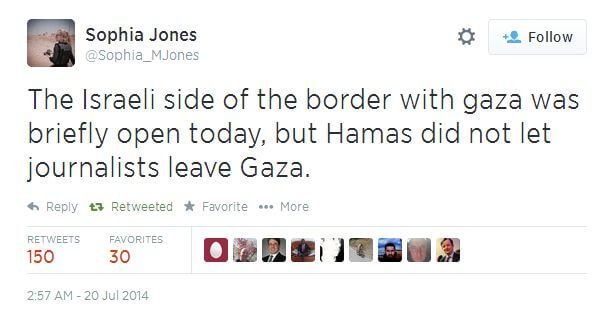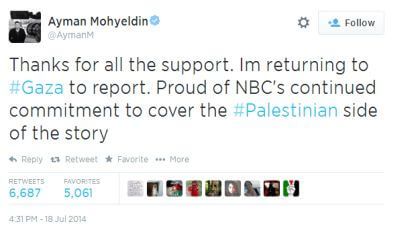Today’s Top Stories
1. The IDF suffered its first fatalities of Operation Protective Edge, and Israel’s second civilian was killed by a rocket.
- 20 year-old 1st Sgt Eitan Barak, of Herzliya; apparently killed by light arms fire.
- 20 year-old Staff Sgt Bania Roval of Holon; shot by a terrorist in a tunnel
- 21 year-old 2nd Lt. Bar Rahav of Ramat Yishai; killed in a friendly fire incident when a nearby tank’s anti-missile defense activated.
- 20 year-old Sgt. Adar Barsano of Nahariya, and 45 year-old Maj. Amotz Greenberg of Hod HaSharon were killed when terrorists who infiltrated Israel through a terror tunnel opened fire on their vehicle.
- 32 year-old Bedouin civilian, Auda al-Wadj, who lived near Dimona, killed by an exploding rocket. Four of his family members, including his three-month-old daughter were also injured.
Shortly before today’s roundup was published, Israel announced the deaths of 13 additional soldiers. Seven were killed when an anti-tank missile fired from a civilian home hit their armored personnel carrier. The other six were killed in separate incidents. The names of the 13 soldiers weren’t released.
More at Haaretz, Jerusalem Post, Times of Israel, and Haaretz.
2. We’re seeing the first indications of Hamas media restrictions. How ominous is this tweet from the Huffington Post’s Sophia Jones?
Meanwhile, The Guardian‘s Peter Beaumont is only journalist I’ve seen brave enough to draw attention to Hamas “minders,” the people keeping tabs on the foreign press corps in Gaza:
These awkward, urgent men are the same watchers you spot in the crowds that gather at the sites of the Israeli air strikes or arrive with their wounded friends at Gaza’s hospitals. They are the men who turn their heads quickly away from the camera or pull up a hood. It is not hard to guess who they are in a conflict that – for western reporters – is defined in large part by what is strikingly absent. They are men associated with the armed factions, most notably Hamas.
In most wars I have covered, you encounter one of the combatant parties, often both, but in Gaza, where death falls from the sky, those fighting are largely invisible except for the impact of their weapons. The result is that you see a war in Gaza through the prism of the suffering of the victims – a conflict in which those willing to offer an organising rationale are absent.
3. Israel’s not only invading Gaza because of the rockets, but also because of the strategic threat posed by terror tunnels infiltrating into the Jewish state. Isabel Kershner of the NY Times, Josh Mitnick of the Wall St. Journal (via Google News) and Eli Lake get it. See also Haaretz, Times of Israel and AP. Meanwhile, the Times of Israel takes a closer look at the dangerous task of tunnel demolition. Mitnick writes:
Defense analysts said the threat of the cross-border attack tunnels is even more potent than Hamas’s rocket arsenal because of the risk of mass casualties or a kidnapping from the border. Israel’s military said destroying the Hamas tunnel network has become a main goal of their ground operation into the Gaza Strip, in addition to stopping rocket fire.
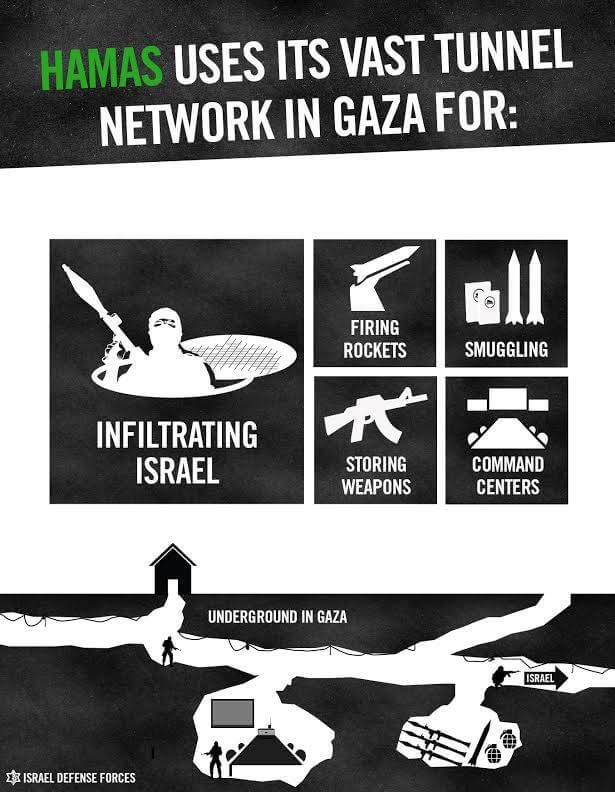
According to Israeli media reports, the IDF has so far uncovered 22 tunnels and 36 tunnel shafts.
4. CNN Yanks CNN Reporter for Calling Israelis Scum: What exactly went wrong for Diana Magnay that got her reassigned?
5. What Did Channel 4’s Jon Snow Imply With This Tweet?: Was the downing of a Malaysian airliner in Ukraine really an Israeli conspiracy?
6. Coke, Israel, and Intellectual Honesty: Take a step back and look at the bigger picture of what is being said, by whom and why, while sipping on an ice cold Coke.
The Ground Offensive Begins
• For details on today’s developments, see live-blogs at the Jerusalem Post, Haaretz, Times of Israel, and i24 News. (For more, see the Friday live-blog posts at the Jerusalem Post, Haaretz, Times of Israel, and i24 News.)
• Reuters: Israeli officials believe Hamas has used up or lost half of its rockets.
• Because of the Arab Spring Winter, the Palestinians aren’t feeling the love of Arab support. The New York Times explains:
But in the chaotic aftermath of the Arab uprisings, many regional governments appear more distracted than ever, by the new challenges to their rule, or in some cases, their intensifying fights against Islamist groups like Hamas . . . .
“Before the uprisings, leaders of the old regime used to at least talk about the Palestinian cause, although they were lying,” he said. “Today we are completely absent. We used to be the No. 1 issue. Now, we’re No. 24.”
(FYI, Diana Moukalled blames Syria for this.)
• Remember a few years ago when apologists claimed that the responsibility of governing would moderate Hamas? I wonder what Nabil Shaath makes of this?
• Did Iran train Gaza’s rocket makers?
• During Thursday’s humanitarian ceasefire, a Washington Post reporter saw men moving rockets into a mosque.
During the lull, a group of men at a mosque in northern Gaza said they had returned to clean up the green glass from windows shattered in the previous day’s bombardment. But they could be seen moving small rockets into the mosque.
• Oh good grief: Remember the 20 missiles discovered in a UNRWA school last week? UNRWA returned them to Hamas . . .
• Ambassador Ron Prosor: There are more rockets in UNRWA facilities.
• The IDF intercepted another Hamas drone, YNet reports. How worrisome are Hamas drones?
• Israel set up an IDNF field hospital on the Gaza border to provide medical care to Palestinians. If I recall correctly, Hamas wouldn’t let Palestinians use the field hospital for treatment in previous conflicts.
• Whoda thought? Around the world, anti-Israel demonstrations are big, and often violent, while the West Bank remains quiet.
Although there have been localized clashes in the West Bank since the brutal murder of an East Jerusalem teenager, Mohammed Abu Khdeir, was followed by the launch of Israel’s Gaza operation, mass protests have been noticeably absent. Although the anger is there, Palestinian security forces’ efforts to contain demonstrations coupled with reticence to see a repeat of the violence and chaos of the second intifada seems to have so far curtailed greater action.
• In Turkey, a newspaper affiliated with Prime Minister Erdogan accuses Turkish Jewry of encouraging the murder of children in Gaza. Meanwhile, Israeli diplomats are evacuating following violent anti-war demonstrations outside missions in Ankara and Istanbul.
• In Paris, “Fourteen French police officers were wounded and 38 people were arrested at an unauthorized rally to protest Israel’s actions in Gaza.” Douglas Murray called London’s protests “a disgusting anti-Semitic spectacle.” And in Indian-controlled Kashmir, a teenage protester was killed when security forces opened fire on an anti-war demonstration. And then there was Boston, where pro-Israel activists had to extricated by police from a pro-Palestinian “die-in.”
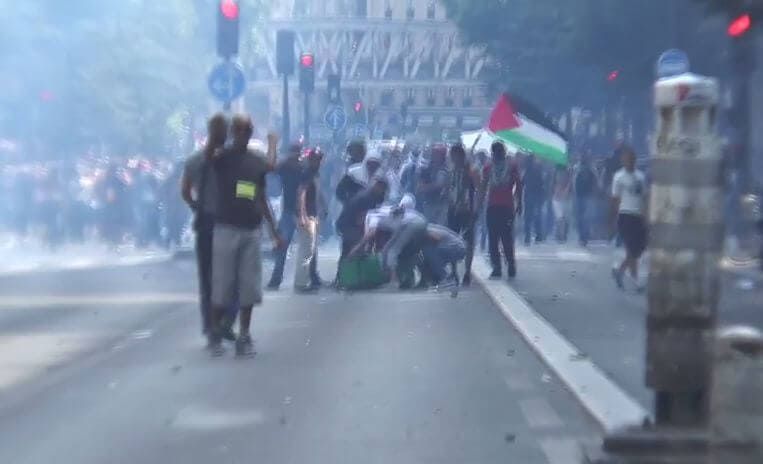
• Demonstrations in Brussels and Zurich featured calls to “kill the Jews,” according to i24 News.
• Bring it on. The Palestinians are threatening to join the International Criminal Court over Gaza. More at the Times of Israel.
• An Egyptian soldier was wounded by a “likely” stray rocket fired from Gaza, AFP reports.
• Foreign workers in Israel back the Gaza operation.
• Hamas apparently rigged a donkey with explosives. I’d ask what People for the Ethical Treatment of Animals has to say about this, but PETA was burnt by a suicide ass before.
Media Angles
• These articles apply to anyone sharing (or thinking about sharing) viral videos and graphic photos on social media too. What’s your “ethical compass?”
On a related note, the Daily Telegraph‘s Brendan O’Neill has his own issues with people posting and sharing photos of dead Palestinian children, what he calls today’s “moral pornography.”
There is also something dehumanising in the constant sharing of photos of screaming or distressed or dead Palestinian children, in the speed with which they have been turned into memes or political products to be swapped between web surfers and tweeters. Is there a danger that these terribly unfortunate children, victims of a war not of their making, have been transformed in death into props for the expression of a cheap online emotionalism, turned into mass-produced and mass-shared images for use by people who are determined to show the world how sensitive they are to other people’s suffering?
It is one thing to show us the reality of war. (Though even here, one has to note the media’s double standards. It is very rare for the media to publish very harrowing photos of injured or dead children from warzones, so why do they do it in relation to the Palestinian territories? Could it be because these photos bolster today’s consensus narrative about Israel being a psychopathic bully picking on the pitiable, allegedly childish nation that is Palestine?)
• NBC News reinstated correspondent Ayman Mohyeldin to Gaza days after he was removed. Los Angelese Times media reporter Robin Abcarian asks, Was Mohyeldin biased?
• Gunmen stormed the newsroom of the Sudanese newspaper, Al-Tayyar, and assaulted the chief editor, Osman Mirghani, who called for ties with Israel.
Eyewitnesses told Sudan Tribune the gunmen blamed Mirghani for his “disgraceful position” towards Israel. They also confiscated all cellular phones and laptops of the newspaper’s staff and attacked several journalists before leaving . . .
Mirghani has recently defended in a TV talk show program the issue of normalising relations with Israel. He also wrote a column on the same issue in Al-Tayyar.
• Andrew Bolt wonders why Australia’s ABC News is “still blind to Hamas savagery.”
Of course, the ABC would deny it explicitly supports Hamas but it has sided with it against its enemy.
• Over at the National Post, Rex Murphy believes the media war has finally tilted in Israel’s favor, and it’s not just because Hamas lost The Onion.
There’s a real turn here in the attitudes and commentary on Israel which mark a departure from the previous occasions of conflict and confrontation. The near automatic and unconditioned sympathy for the “Palestinian cause” we have seen before is not being as quickly or reliably manifested this time. Hamas and its brethren in terror are not getting quite the pass they have on previous occasions.
• Ex-Malaysian mufti writes that Hitler might have been right to exterminate the Jews. That puts him at odds with Iran’s supreme leader, Ayatollah Ali Khamenei, who still doesn’t believe the Holocaust happened at all.
• Justifying Hamas rocket fire is bad enough, but did Knesset member Haneen Zoabi cross a line by publishing her views on a Hamas web site? Check out the Jerusalem Post and MEMRI, then draw your own conclusions. Warning: You may be prejudiced by Hamas’ praise of Zoabi.
• Gaza invasion or shot down Malaysian airliner? Newspapers wrestle with big news and limited space.
• Israeli diplomats continued their media offensive. Ido Aharoni got op-ed space in the Washington Times, Naftali Bennett was on Sky News, and CNN‘s Jake Tapper discussed the crisis with the IDF’s Lt. Col. Peter Lerner and Hamas official Ghazi Hamad.
Commentary and Analysis
• See staff-editorials in the New York Times (been there, done that), Wall St. Journal (via Google News), Buffalo News, Globe & Mail, and New York Post.
• Elliott Abrams slams The Kerry-Qatar Axis:
“What is Kerry doing?” is, on this point, a fair question. We should be trying to marginalize the Qatari role, not preserve it or enhance it.
(Indeed, Qatar’s ceasefire offer adopts most of Hamas’ demands.)
• Avi Dichter: Put an end to terrorism roulette.
• Jonathan Schanzer discussed the ground war in a Wall St. Journal video.
• Charles Krauthammer: Moral clarity in Gaza
• Tony Badran: Israel Assisting Arab National Security Against Iran
As I have argued before, Gaza represents but the southern front – Lebanon being the northern counterpart – of an Iranian strategy to deploy long-range rockets and missiles on Israel’s borders capable of targeting all of its cities . . .
The deterrence that Israel established in Lebanon is what it is trying to recreate in Gaza, in cooperation with Egypt. In fact, it is not far-fetched to say that, insofar as it intercepts destabilizing Iranian weapons, or strikes them before entering Lebanon or Egypt, Israel is acting as a guarantor of Arab national security in the eastern Mediterranean.
• Reserve IDF officer explains in the Daily Telegraph op-ed why a ground offensive is necessary to deal with Hamas.
• Melanie Phillips: Not enough dead Israelis for the West.
• Ben-Dror Yemini: Let’s talk about proportion
• Barak Ravid: World leaders believe Bibi — for now
The main reason Israel has received such broad support internationally for its Gaza operation is that unlike in the past, the world’s leaders believe Netanyahu . . . . In the past two weeks the attitude to Netanyahu has turned around. The world’s leaders are showing him empathy and understanding. They know that when he tells them that he went into this operation through lack of choice he is not lying. They saw how he dealt with the internal political pressures, how he delayed action for several days and even accepted the Egyptian cease-fire plan. They are convinced that this is not some trick to provide international legitimacy for a re-occupation of Gaza, but rather his authentic desire to avoid escalation.
• Cartoonists weigh in. Michael Ramirez gets my thumbs up; Adam Zyglis of the Buffalo News is, unfortunately, morally ambivalent.
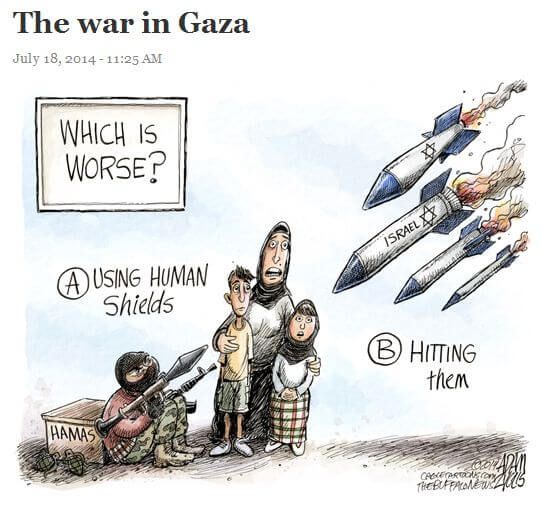
• Golda Meir was right (part 2)
• Professor Nathan Brown: 5 Myths About Hamas
• Nicholas Kristof: Who’s Right and Wrong in the Middle East? (spoiler alert: nobody, really)
• Iranian fingerprints are all over the Israel-Hamas conflict, argues Sayeh Hassan in the Toronto Star.
None of this would be possible without extensive funding from Iran. At one point, the government of Egypt revealed that Iran was funnelling upwards of $300 million annually to Hamas.
Additional numbers are equally staggering. Prior to Israel’s current operation, terror groups in Gaza possessed an estimated 10,000 missiles. Hamas operatives, many of whom were trained in Iran, now also number at least 10,000.
• For a sense of what the other side is saying, see op-eds in The Daily Beast, Sydney Morning Herald, and the London Review of Books,
Rest O’ the Roundup
• Israel isn’t opposed to the world powers extending the nuclear talks with Iran for a few more months. The Jerusalem Post writes:
“It would be better for us to have an extension than to have a bad deal,” one Israeli official told The Jerusalem Post. “The worst outcome would be a bad deal.”
• Israel may take on Iran when the nuclear talks expire, says Michael Oren.
• Pope demands justice for Argentine terror attack.
• The suicide bomber who killed five Israelis on a tourist bus in Burgas, Bulgaria, was identified as Mohammad Hasan al-Husseini, a French-Lebanese national. Reuters coverage.
Featured image: CC BY flickr/m01229, Paris demonstration via YouTube/LTL News 2
For more, see yesterday’s Israel Daily News Stream and join the Israel Daily News Stream on Facebook.

